The confusion about embodied carbon and scope emissions in real estate and infrastructure
When we published our blog post on “Real Estate and Sustainability”, we didn’t expect the term “Embodied Carbon” to raise so many questions. What is “Embodied Carbon”? Is it just another term for “Scope 3 Emissions”? In this blog post, we first explore why CO₂ emissions (we use the term CO₂ emissions synonymously with the term greenhouse gas emissions in this blog post) of the real estate sector are particularly relevant for achieving future climate goals. Then, we clarify what lies behind the term “Embodied Carbon” and explain the connections to the Greenhouse Gas Protocol’s “Scope 3 Emissions” and the challenges both approaches share. Finally, we provide an outlook on the steps towards a low-carbon future in the real estate sector.
Embodied Carbon, CO₂ emissions and climate change
We are in the midst of a climate crisis. We must drastically reduce CO₂ emissions to keep global warming well below 2°C – ideally below 1.5°C – to meet the Paris Climate Agreement goals and avoid the worst effects of climate change.
Massive decarbonisation efforts will be necessary [1] to reduce CO₂ emissions to 50% of 2010 levels by 2030, and the associated costs will be enormous. However, they are cheaper than the costs related to inactivity.
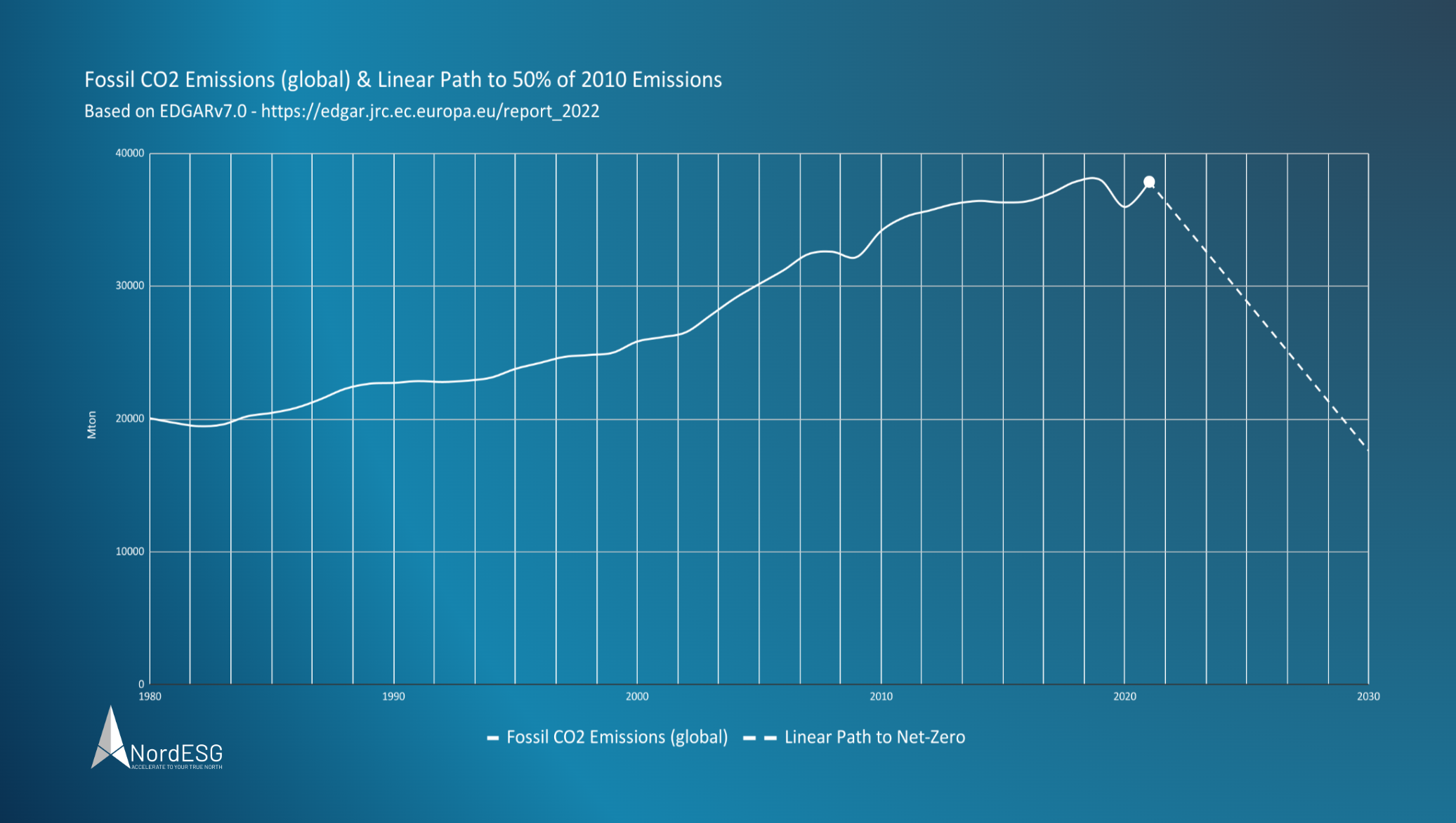
Fossil CO₂ Emissions (based on EDGARv7.0 data) and linear pathway to reduce CO₂ emissions to meet 2030 goals [2]
Beyond the 2030 milestone, “Net Zero” should be achieved by 2050. Critical components for this include transitioning to a low-carbon/carbon-free and circular economy, as well as increasing energy efficiency.
Time is of the essence
The Intergovernmental Panel on Climate Change (IPCC) states in its presentation of the “Sixth Assessment Report – Synthesis Report” [3] dated March 20, 2023: “Pace and scale of climate action are insufficient to tackle climate change”.
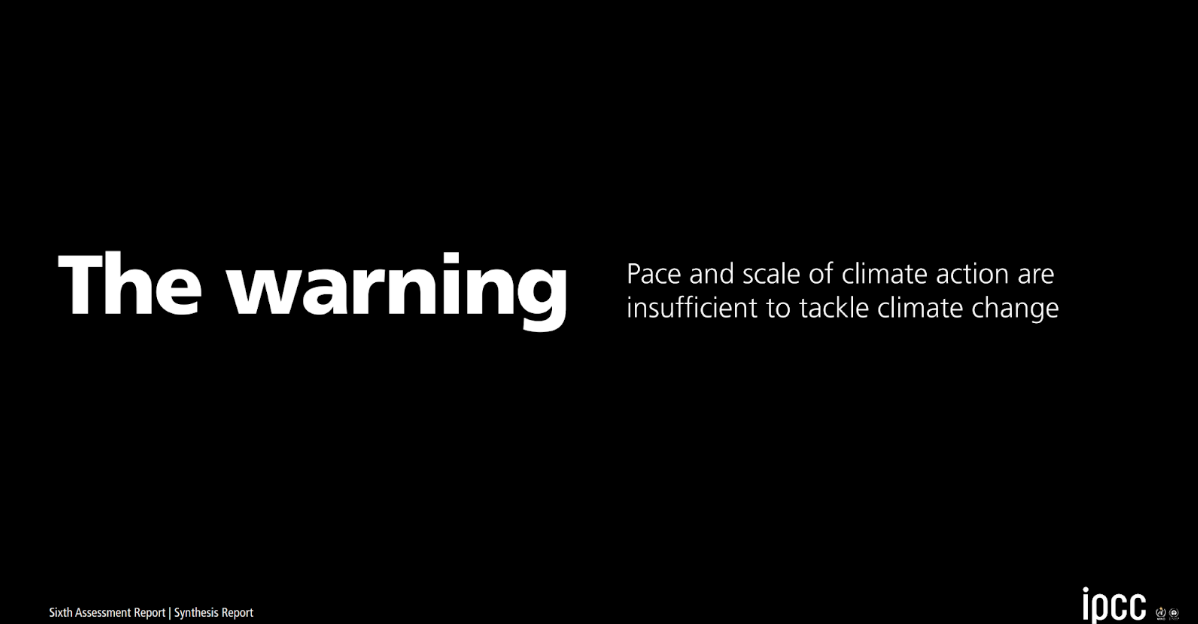
Slide from IPCC, Sixth Assessment Report | Synthesis Report [3]
In the presentation to the sixth assessment report, the challenges are described as
- “Cut emissions quickly, sharply to create a safer, sustainable world”
- “Scale up practices and infrastructure to enhance resilience”
- “Cut global GHG emissions by nearly half by 2030”
- “Action required along numerous dimensions”
Got questions about Embodied Carbon or Scope 3 Emissions?
Book a free and nonbinding discovery call to discuss your questions with one of our carbon accounting experts, and learn how we can help you with Embodied Carbon and Scope 3 Emissions.
Why real estate is a critical component in achieving climate goals
Buildings represent approximately 40% of energy consumption in the European Union and account for about 36% of CO₂ emissions. Globally, 39% of annual global greenhouse gas emissions can be attributed to real estate (28% as “operational carbon” and 11% as “embodied carbon”).
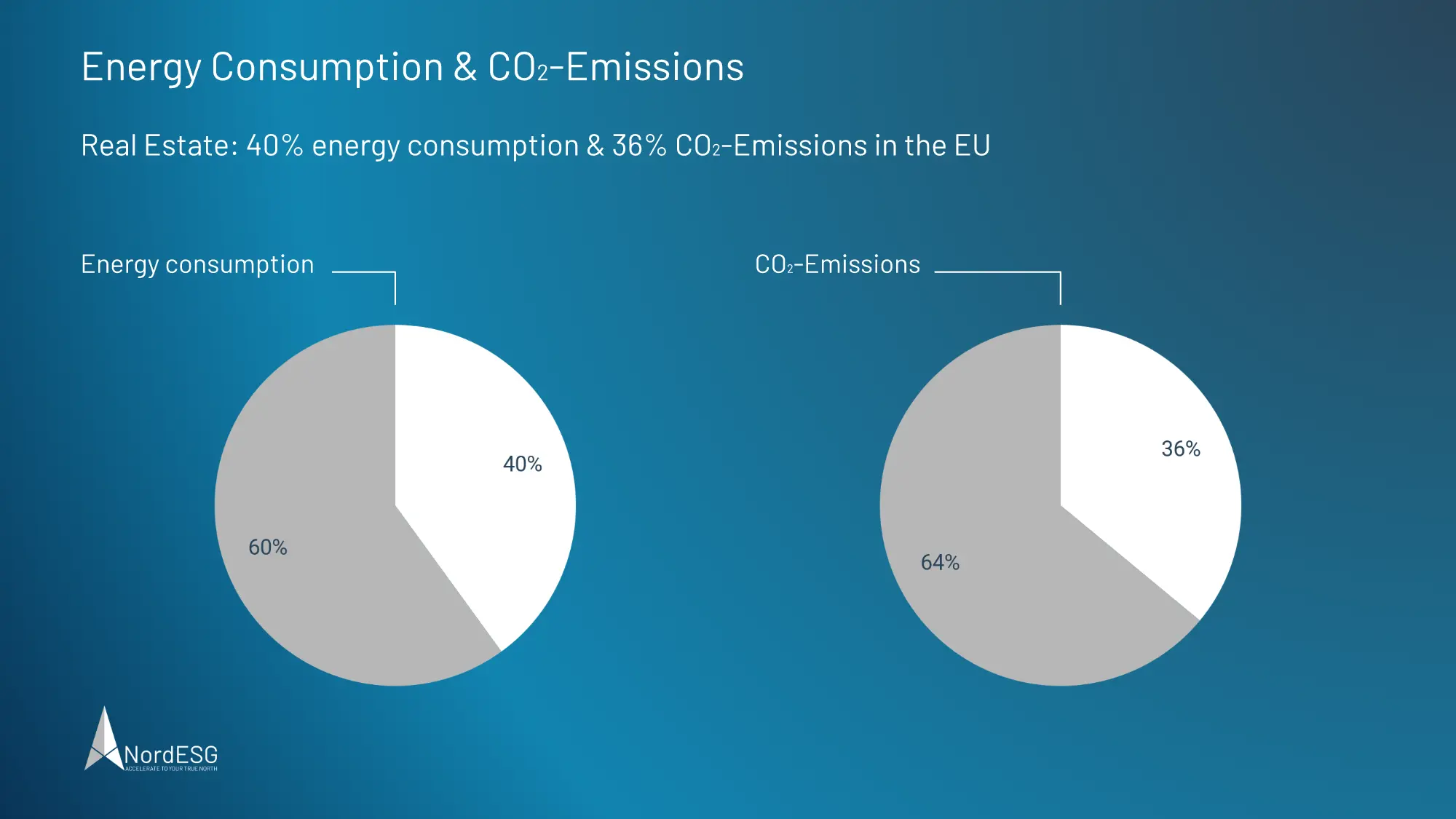
The improved energy efficiency of buildings and the increased decarbonisation of energy sources used will lead to a change in the ratio of “Embodied Carbon” to “Operational Carbon”, and the share of “Embodied Carbon” will increase in the future. Given the numbers, it is clear that there is a massive potential for the real estate sector to contribute to reducing greenhouse gas emissions.
What is Embodied Carbon, and is there a difference between Scope 1, 2, and 3 emissions?
What is behind the term “Embodied Carbon”? Are there similarities to Scope 1, 2, and 3 emissions of the Greenhouse Gas Protocol, and what are the common challenges both approaches face?
What is “Embodied Carbon”?
When we discuss CO₂ emissions, we often refer to those that arise during an asset’s use or operation. For example, if natural gas is used to heat a building, CO₂ emissions are generated during its combustion. Less obvious are emissions that are already “embedded” in the building.
The emissions that arise during operation can be called “Operational Carbon”. Those that result from raw material extraction, the production of building materials, and other processes up to the decommissioning are referred to as “Embodied Carbon”.
More specifically, the term “Embodied Carbon” refers to those greenhouse gas emissions that occur or have already occurred during the entire lifecycle of a building and cannot be attributed to “Operational Carbon”. That includes all processes upstream and downstream of the actual usage phase. As shown in the figure below, this also includes CO₂ emissions from extensive renovation or refurbishment.
Classification of CO₂ emissions and “Embodied Carbon” by the World Green Building Council
The World Green Building Council (WGBC) assigns “Embodied Carbon” emissions to various use stages.
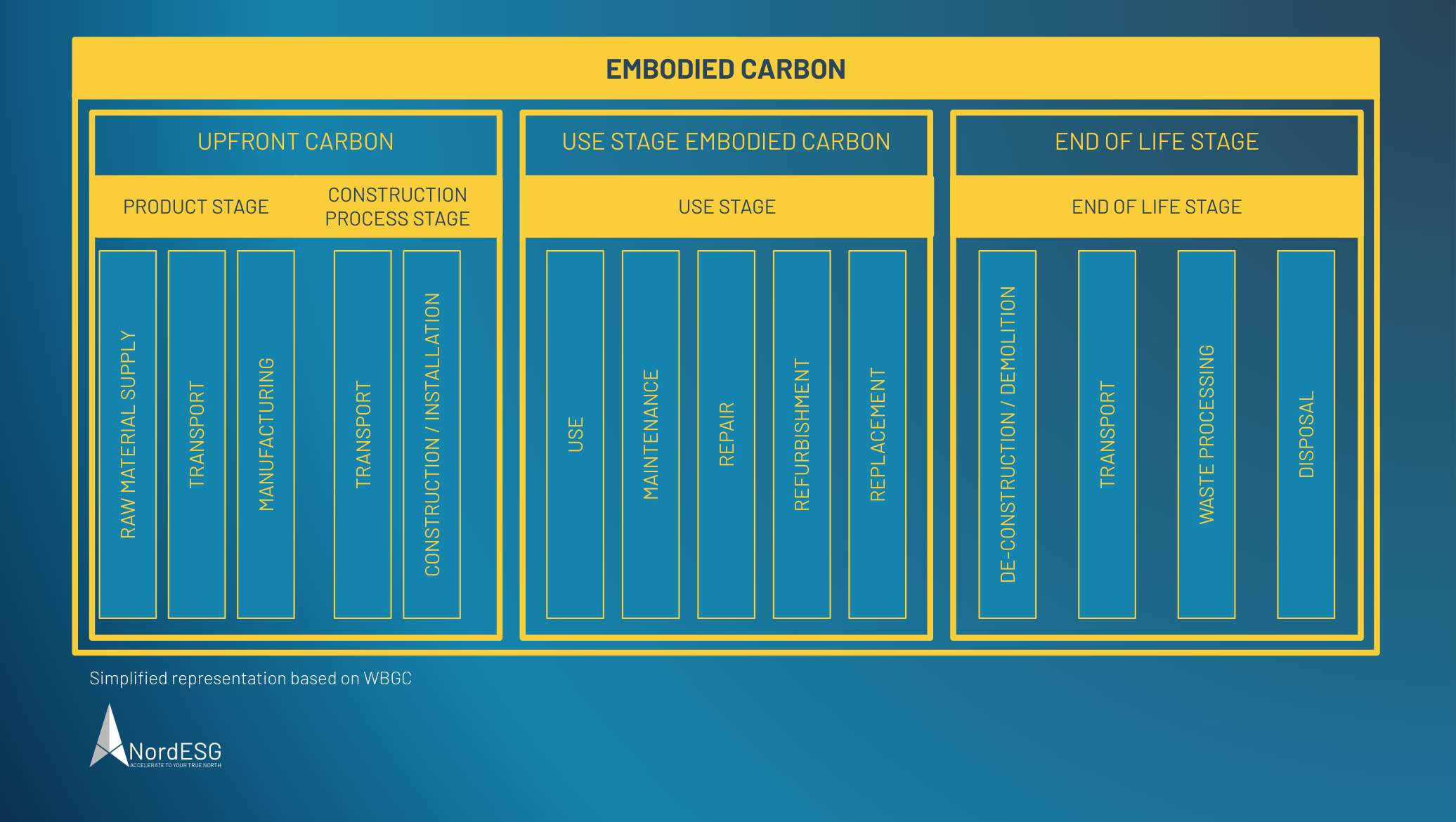
Embodied Carbon along different usestages based on WBGC [4]
The CO₂ emissions that occur during the extraction and production of building materials and the construction phase are defined as “Upfront Carbon”. “Use Stage Carbon” refers to greenhouse gas emissions during the usage phase, for example, through maintenance or renovations. Finally, the “End of Life Embodied Carbon” emissions are generated at the end of a building’s life cycle.
The WGBC has developed the following definitions along the three phases shown in the figure above:
Upfront embodied carbon: “The emissions caused in the materials production and construction phases of the lifecycle before the building or infrastructure begins to be used. In contrast to other categories of emissions listed here, these emissions have already been released into the atmosphere before the building is occupied or the infrastructure begins operation.” – WGBC
Use stage embodied carbon: “The emissions associated with materials and processes needed to maintain the building or infrastructure during use such as for refurbishments. These are additional to operational carbon emitted due to heating, cooling and power etc.” – WGBC
End of life embodied carbon: “The Carbon Emissions associated with deconstruction/demolition of a building or infrastructure’s life cycle which occurs after its use.” – WGBC
Scope 1, 2, and 3 Emissions of the GHG Protocol
Before we address the similarities and interoperability of “Embodied Carbon” and “Scope Emissions”, we provide a brief overview of the scope emissions of the Greenhouse Gas Protocol (GHG Protocol).
The GHG protocol distinguishes emissions into three categories:
Scope 1 emissions are emissions from sources directly owned or controlled by the reporting company. The simplest example is a company’s heating system and the emissions attributable to its operation.
Scope 2 emissions, on the other hand, are indirect emissions, such as those generated by the production of purchased electrical or thermal energy.
Scope 3 emissions represent another class of indirect greenhouse gas emissions not included in Scope 2. They are divided into “upstream” and “downstream”, depending on whether they occurred along the value chain.
The similarities and differences between “Embodied Carbon” and “Scope Emissions”
So is “Embodied Carbon” just a different layer of “Scope 3 Emissions”? The answer is: “It depends”. Seen from the perspective of the Greenhouse Gas Protocol, “Embodied Carbon” can be classified into various emission categories of the Greenhouse Gas Protocol, i.e., Scope 1 or 3, depending on where and in what context the emissions occur.
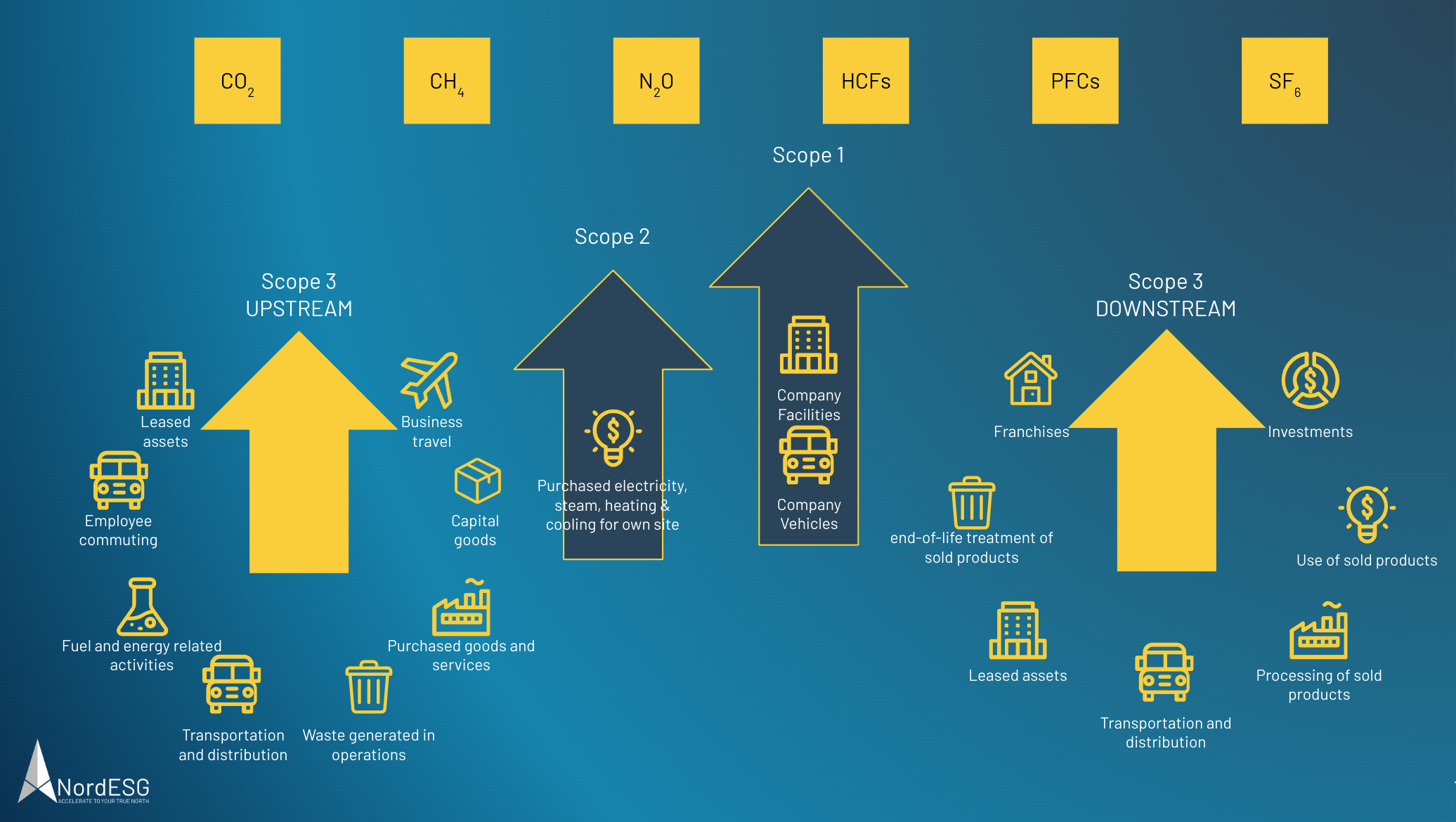
Scope 1, 2, and 3 emissions based on the Greenhouse Gas Protocol [5]
Scope 3 emissions fall into the category of indirect emissions and are distributed across all upstream and downstream activities. They often represent the largest share of total CO₂ emissions. At the same time, capturing them accurately is challenging, as extensive information about the respective upstream and downstream processes is required.
| Scope 3 Up- and Downstream Categories | |
Upstream Categories
|
Downstream Categories
|
Our blog posts on scope emissions are here, here and here.
The classification of “Embodied Carbon” as Scope 3 emissions is expected to be more common than in other categories. For example, if a building is purchased, the associated emissions are classified as other indirect emissions (Scope 3), as they are upstream emissions (cf. above – Upstream Categories (7) “Capital Goods”).
Understanding that the Greenhouse Gas Protocol takes a different approach than the World Green Building Council is necessary to better understand the classification of emissions along the two frameworks.
The WBGC focuses on an asset (building or infrastructure) and the embodied carbon that arises over the life cycle, i.e., without “Operational Carbon” or operational greenhouse gas emissions. The question is, therefore, which emissions occur during the production of building materials, during the construction phase, through renovation and remodelling work, and during demolition.
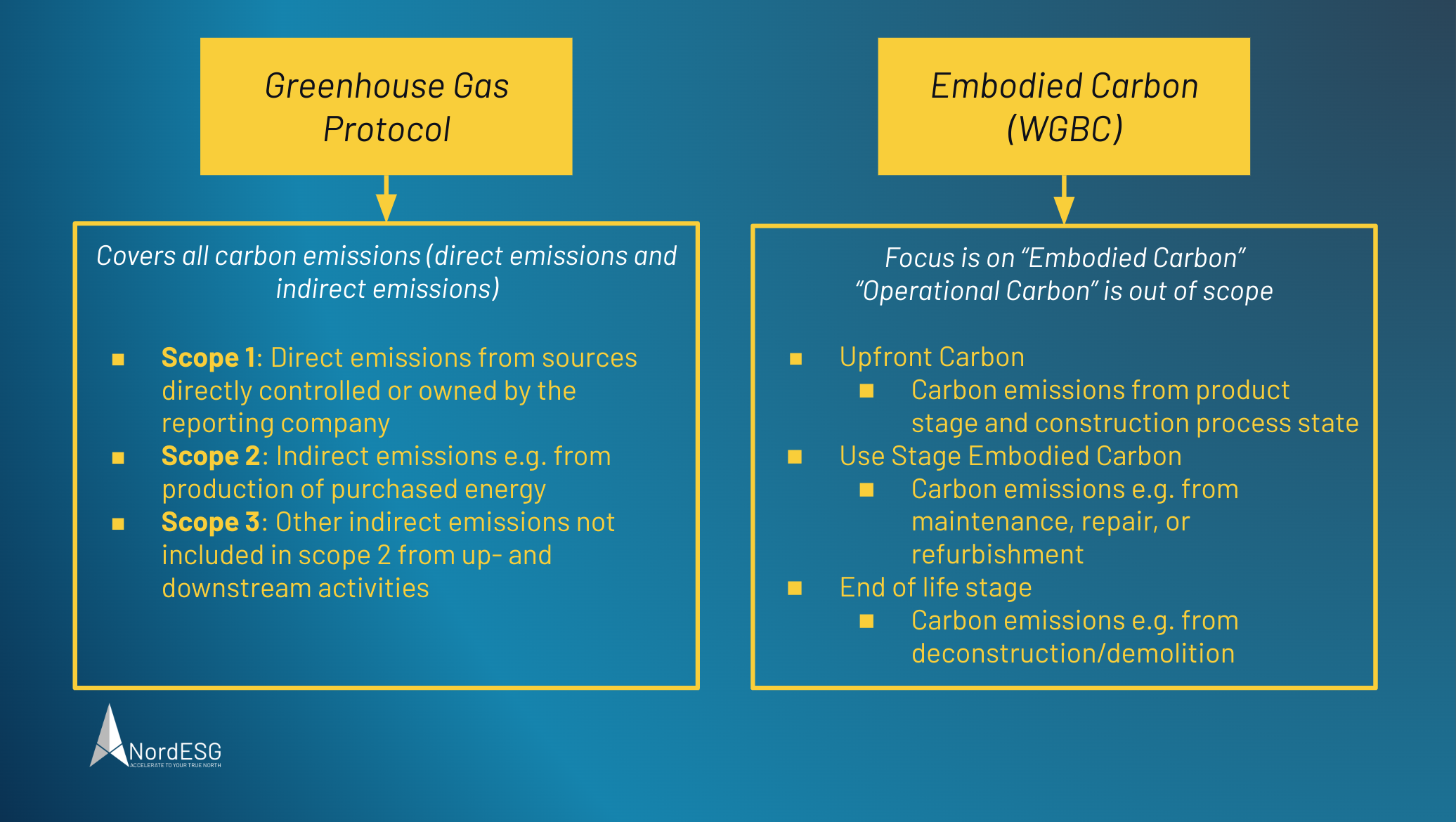
Comparison of WBGC and Greenhouse Gas Protocol focus and scope
In contrast, the Greenhouse Gas Protocol focuses on differentiating direct and indirect emissions, including greenhouse gas emissions from operations. Therefore, an allocation of “Embodied Carbon” to the categories of the Greenhouse Gas Protocol is possible, with the question of direct control over the emissions, as outlined above, being the first indicator for the allocation.
Different focus, same challenges
Although the WBGC and the GHG Protocol classify CO₂ emissions differently, both methods face the same challenge: reliable and high-quality data are an essential foundation but not always available.
Specifically for the building sector, “Environmental Product Declarations” or “EPDs” can contribute to a better understanding of the CO₂ footprint and other environmentally relevant properties of building materials. For existing buildings, traceability of the building materials is often more complex. In such cases, estimations may lead to sufficiently good data.
The same challenges ultimately lead to a similar prognosis: what applies to “Scope 3 emissions” also applies figuratively to “Embodied Carbon”: data quality will improve over time.
Net-Zero Embodied Carbon – the challenge of decarbonisation
While operational emissions can be reduced by energy efficiency measures, using renewable energy sources and by user behaviour, “Upfront Carbon” is a fixed component embedded in the DNA of a building.
The WBGC has set ambitious targets to reduce the carbon intensity of buildings and infrastructure significantly:
- “By 2030, all new buildings, infrastructure and renovations will have at least 40% less embodied carbon with significant upfront carbon reduction, and all new buildings must be net zero operational carbon.”
- “By 2050, new buildings, infrastructure and renovations will have net zero embodied carbon, and all buildings, including existing buildings, must be net zero operational carbon.”
The WBGC definiens net-zero embodied carbon as follows:
- “A net-zero embodied carbon building (new or renovated) or infrastructure asset is highly resource efficient with upfront carbon minimised to the greatest extent possible and all remaining embodied carbon reduced or, as a last resort, offset in order to achieve net zero across the lifecycle.”
And further explains that:
- “Net zero embodied carbon should be pursued as part of a whole lifecycle approach to carbon reduction that includes net zero operational carbon. A net zero embodied carbon building (new or renovated) or infrastructure asset is highly resource efficient with upfront carbon minimised to the greatest extent possible and all remaining embodied carbon reduced or, as a last resort, offset in order to achieve net zero across the lifecycle.”
- “This new definition makes clear that net-zero embodied carbon should be pursued as part of a strategy to decarbonise the whole lifecycle. It also recognises the urgency of addressing upfront emissions, which are being released into the atmosphere now, as we continue to extract and manufacture materials and products for construction.”
Conclusion
Buildings and other infrastructure have the potential to make a substantial contribution to reducing greenhouse gas emissions, both in terms of embodied and operational carbon. However, we must urgently realise this potential to achieve the goals of the Paris Climate Agreement. The WBGC proposes ways to do so, and we hope that this call to action will be heard by numerous actors and put into practice.
Regarding the question of where “Embodied Carbon” emissions can be accounted for using the Greenhouse Gas Protocol, the answer is yes, but it will depend on other frame conditions (direct control, up- or downstream activity). With increasing awareness of the relevance of CO₂ emissions, the data situation in both cases will hopefully continue to improve so that all stakeholders can make well-informed decisions based on this foundation.
Sources and further reading
[1] Vaclav Smil – Numbers don’t lie – Decarbonization Algebra
[2] Carbon data
[3] IPCC report
[4] WBGC – Bringing embodied carbon upfront – Coordinated action for the building and construction sector to tackle embodied carbon
[5] Greenhouse gas protocol
Autodesk & Statista – Building the future – Keeping up with a growing urban population
GlobalABC Roadmaps for Buildings and Construction 2020 – 2050 – Towards a zero-emission, efficient, and resilient buildings and construction sector
About NordESG
NordESG is an advisory firm helping corporates develop, articulate and execute their ESG and sustainability strategies. Our work includes sustainability performance reporting support under various ESG frameworks, strategy development or conducting materiality assessments. By doing so, we help businesses meet their disclosure compliance requirements like CSRD but also help them proactively communicate their strategy to other stakeholders like investors, customers and local communities in which they operate. Our work is focused mainly on Europe and North America.
Discovery Call
Book a free discovery call below
Get in touch via email
Disclaimer
This communication is marketing material. The views and opinions contained herein are those of the author(s) on this page, and may not necessarily represent the views expressed or reflected in other NordESG communications or strategies.
This material is intended to be for information purposes only. It is not intended to provide and should not be relied on for accounting, legal or tax advice, or investment recommendations. Reliance should not be placed on the views and information in this document when taking individual investment and/or strategic decisions. Information herein is believed to be reliable, but NordESG does not warrant its completeness or accuracy.
Some information quoted was obtained from external sources NordESG consider to be reliable. No responsibility can be accepted for errors of fact obtained from third parties, and data and information contained in this communication may change in the future. The views and opinions expressed in this communication may change.